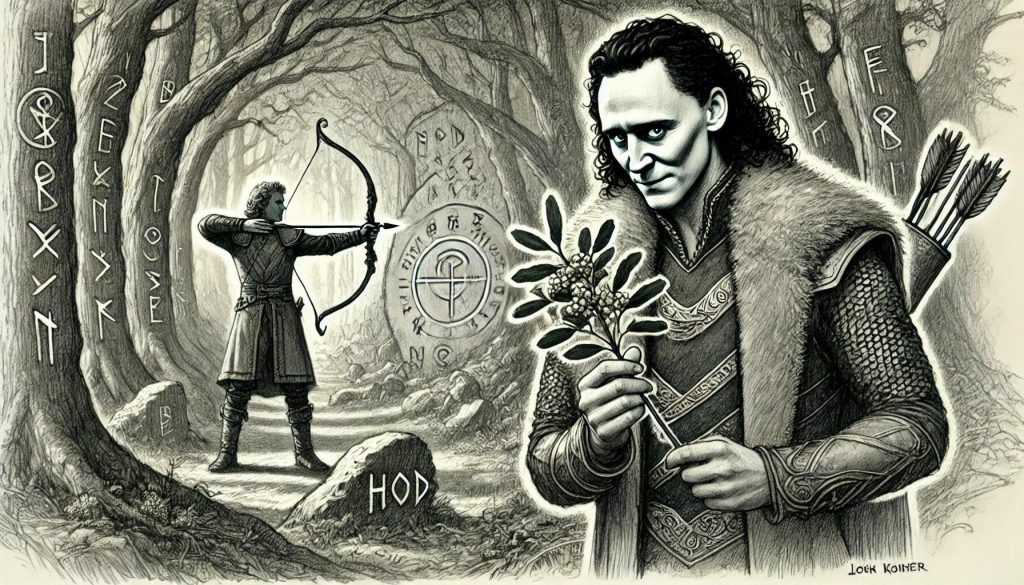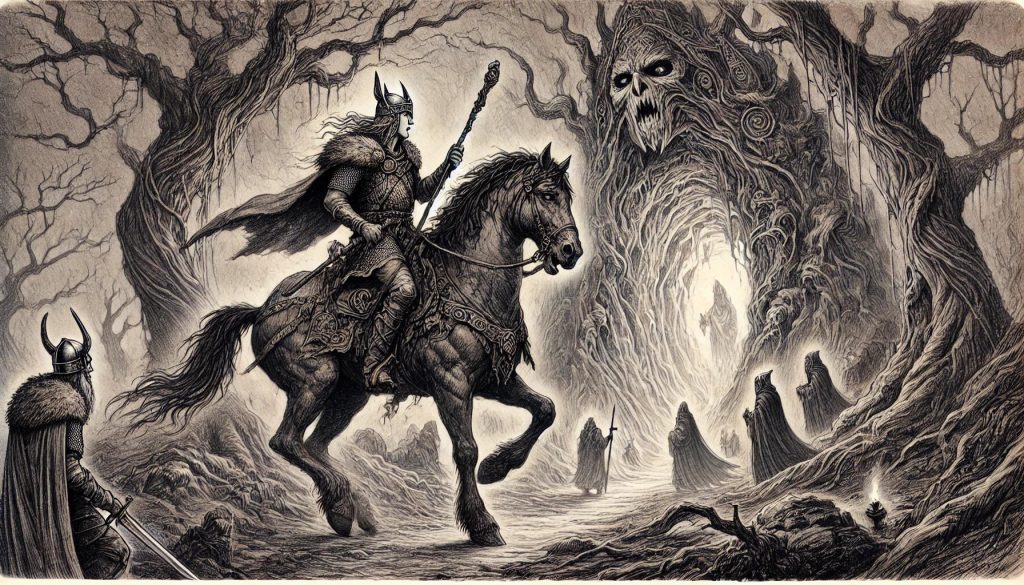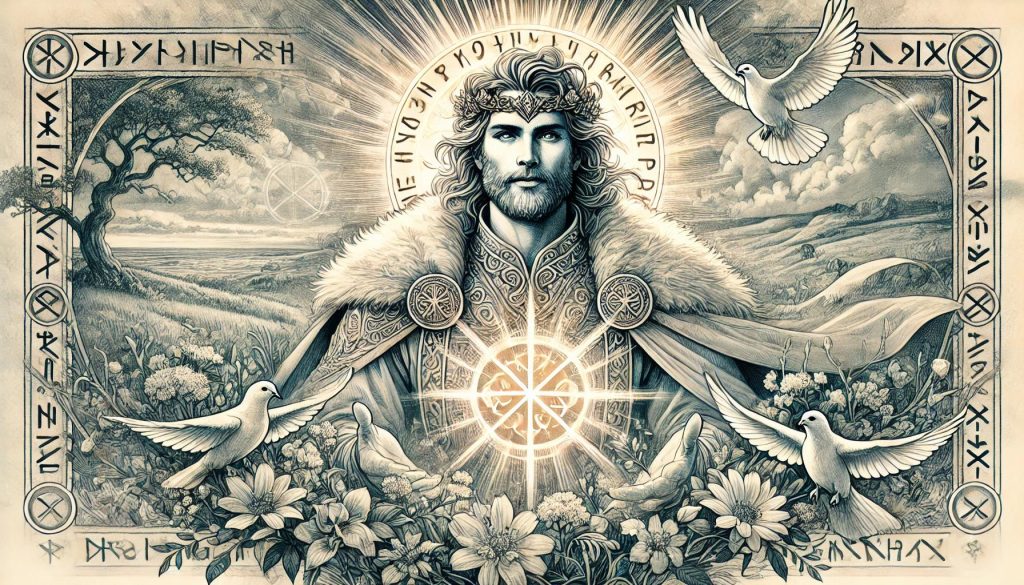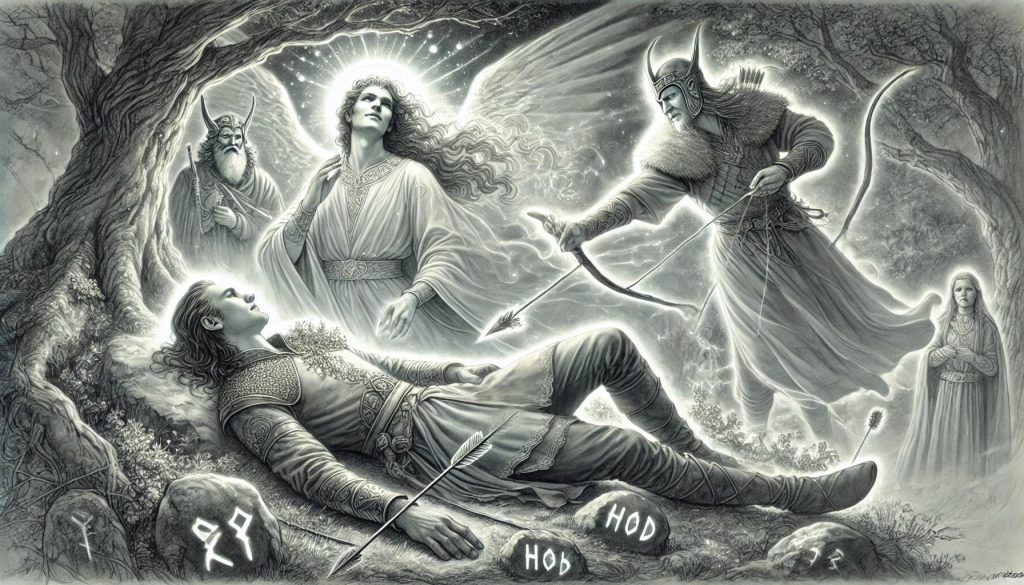Aesir Goddesses, Aesir Gods, Baldur, Frigg, Hermod, Hodr, Loki, Norse Goddesses, Norse Gods, Norse Mythology, Odin, Tales of the Gods, Thor
The Death Of Baldur
The death of Baldur is a key event in Norse mythology, as recorded in Old Norse texts. It sets the stage for the end of the world, known as Ragnarok. Baldur, a god of light and goodness, is the son of Odin and Frigg. His death is a turning point, bringing darkness to Asgard.
This event is a major shift in Norse history and mythology. It shows the deep impact of Baldur’s death on the Nine Worlds.
The Death of Baldur: An Introduction
In Norse mythology, Baldur’s death is a tragic event. To grasp its depth, we dive into the rich world of Norse myths, focusing particularly on Balder’s tragic death. This world is full of gods, goddesses, and epic stories. It helps us understand the importance of Balder’s story and his untimely death.
At the core of this tale are Odin, the All-Father, and his wife, Frigg, the goddess of love. Their son, Baldur, is loved for his beauty and cannot be hurt, but this makes him a target for tragedy.
Baldur has dreams of his death and tells his mom, Frigg. She tries to protect him by making promises from everything, not to harm him.
But she misses one thing: mistletoe. Loki, the trickster, sees this as a chance to cause trouble.
Loki makes a dart from mistletoe and tricks Baldur’s brother, Hodr, into throwing it at him. This act changes everything in Norse mythology.
This event shows that even the strongest can face tragedy. Baldur’s death teaches us about life’s fragility. It’s a lesson that touches us all.
As we examine Baldur’s story more closely, we will see how people tried to bring him back and how his death affected the world. This story is full of symbols and meanings that still matter today.
Let’s explore the world of Norse mythology with Baldur’s story, which has moved people for centuries.
Baldur’s Dreams and Fears
Baldur’s Importance in Norse Mythology
“He dreamed about his own death, and this troubled him greatly, for he knew deep in his heart that his dreams held the power of prophecy.”
Baldur was a key figure in Norse mythology. He was known for his light and purity, which contrasted with figures like Thor. But he was more than just a god of light. His dreams and fears added depth to his story.
In Norse mythology, dreams were seen as powerful. Baldur’s dreams were no different, filled with cryptic messages from a messenger. They often predicted events that would change his life. These visions filled him with fear, leading to his death.
Baldur’s dreams were tied closely to his destiny and the prophecies about him. The gods worried about a tragedy that would happen to him, especially the foretold death of Balder. They tried hard to protect him.
Even with the fear, Baldur’s dreams offered hope. They reminded him of his role in Norse mythology. As a god of light, he stood for purity and goodness, unlike Thor, the god of thunder. His dreams showed how crucial he was in keeping balance in the divine world.
Baldur’s dreams and fears gave us a closer look at his character and the events that happened to him. They show how prophecies and visions shaped the lives of gods and humans in Norse mythology. Baldur’s story teaches us about the power of dreams and prophecies in the Norse world.
The Plans to Protect Baldur
The Role of Loki in the Plot
Baldur, the god of light, was loved by all. The Norse gods wanted to keep him safe. They feared harm could come to him. So, they made plans to protect him.

They knew Baldur was popular and well-liked by everyone, including the mighty Thor. This made him more vulnerable. So, they took steps to keep him safe.
- Invulnerability: The gods made Baldur almost invulnerable. They got promises from every living thing and object in the nine realms not to harm him.
- Constant Watch: Even though he was hard to hurt, gods watched over Baldur all the time. They never left his side, day or night, looking for danger.
- Defensive Measures: The gods built strong walls and barriers around Baldur. These were meant to keep away any threats and keep him safe.
- Divine Intervention: The gods also used their powers to protect Baldur. They made his defenses stronger and kept away evil forces.
But a big threat came from Loki, the trickster god. He was always up to something tricky. Loki wanted to harm Baldur, which led to a sad event.
Loki said he wanted to help keep Baldur safe, but he was really jealous and resentful of him. This led him to act badly, breaking the safety plans.
Loki found a way to use a mistletoe, which was not covered in the safety promises. He made a dart from it and planned to use it on Balder, sealing the fate of the death of Balder.
Loki tricked Hodr, Baldur’s blind brother, into shooting the dart at Baldur. This broke the safety shield around Baldur, causing his death.
The Fatal Incident
The story of Baldur’s death is filled with sadness. It was caused by Loki’s clever trick. This event started with a simple plant, mistletoe, which had deep meaning in Norse myths and was used to pierce Baldur’s heart.
Baldur was a favorite among the Norse gods, known for being unbeatable. His mother, Frigg, had made a promise from every being and thing to protect him, swearing an oath to prevent the death of Balder. Everyone thought Baldur was safe.
But Loki, the tricky god, found a way to defeat Baldur. He learned that mistletoe, a plant Frigg had forgotten, could harm him. This plant was the key to Loki’s plan.
Loki made a dart from mistletoe and gave it to Hod, Baldur’s blind brother. Hod was not part of the game because he couldn’t see. Loki tricked him into throwing the dart at Baldur.
Hod threw the dart without knowing it was mistletoe. The gods watched in shock as the dart hit Baldur, killing him. This was a plant Frigg had overlooked, making Baldur vulnerable.
This event changed Norse mythology forever. It left everyone, gods, and humans, feeling deep sadness.
The Aftermath of Baldur’s Death
Baldur’s death deeply affected the gods and people of Asgard. The world became dark, and everyone felt deep sadness, which spread across the Nine Worlds.
The gods loved Baldur for his beauty, purity, and kindness. They were devastated when he died, weeping for Balder. They missed him a lot, finding it hard to imagine life without him. Everyone in Asgard and beyond mourned the loss of the beloved god.
The grief was huge, unlike anything before. The air felt heavy with sadness. Even nature seemed to cry, with trees bending and rivers flowing with tears. This showed how deep the sadness was.
The gods found comfort in each other, sharing their sorrows and happy memories of Baldur. They met at the hall of mourning to honor him. This gathering was a solemn event that reached far and wide.
After Baldur’s death, Asgard changed. It became a sad place, as the gods felt the loss deeply. Without Baldur, they felt a huge gap. They wondered about their own deaths and the fleeting nature of life.
But, in their sadness, the gods found unity. They decided to work together to find out who killed Baldur and make things right. They were determined to bring justice and balance back to the Nine Worlds.
Baldur’s death changed Norse mythology. It moved from a world of peace to one of tragedy, where Thor could not prevent the downfall. This event had a lasting effect on the gods and their actions.
Attempts to Revive Baldur
In Norse mythology, death was final, but there were efforts to bring Baldur back. The gods and goddesses were deeply saddened by his death. They wanted to revive him.
Hermod, Baldur’s brave brother, led the charge to revive him. He went to the underworld, or Hel, to try. This was a bold move to bring back his brother, hoping to defy Balder’s tragic death.

Hermod faced many challenges on his journey. He had to cross tough landscapes, navigate treacherous rivers, and overcome fierce guardians. His determination and bravery were clear throughout.
When Hermod reached Hel, he asked the ruler to bring Baldur back. His plea touched the hearts of everyone in Hel, and the gods and goddesses were hopeful for a miracle.
But Hermod’s plea didn’t change Balder’s fate, and the giantess Thokk refused to weep for him. The ruler of Hel agreed to release Baldur but with a condition. Every living and non-living being in the nine realms had to cry for his return. This was a huge ask.
The gods and goddesses worked hard to make every creature cry for Baldur. They reached out to all, trying to stir their emotions. They hoped to bring tears from even the smallest beings.
Many creatures felt the pain of Baldur’s death and cried for him. But, some didn’t, out of envy or indifference. These few stopped Baldur from coming back, leaving the gods sad.
Even though they failed, Hermod’s journey and the gods’ efforts showed their love for Baldur. They were willing to do anything to bring him back.
Baldur’s story is a powerful reminder of love, loss, and the lengths we go to for those we care about.
The Consequences of Baldur’s Death
Baldur’s death shook the realms of Norse mythology, starting a chain of events leading to Ragnarok. His loss, as the god of light and purity, tested the gods’ strength and relationships. It also led to the end of their world.
The gods and goddesses felt deep grief and despair after Baldur died. He was known for his beauty, kindness, and wisdom. Without him, the gods, even the brave Thor, felt a huge void in their hearts.
Loki, the trickster god, was behind Baldur’s death. His actions showed his true nature and caused anger among the gods, setting the stage for more chaos.
When Baldur died, the news spread across the Nine Worlds. The gods couldn’t protect their friends, which broke their trust. This led to events that ended in Ragnarok, a big battle between chaos and order.
As told in Norse myths, Baldur’s death was a sign of doom. It meant the end of the world, leading to a final battle that started a new era.
In conclusion, Baldur’s death had big effects on Norse mythology. It broke the trust among the gods and led to Ragnarok, a future that even Odin’s eight-legged horse, Sleipnir, could not outrun. His death showed how fragile the gods’ world was.
Interpretations and Symbolism
The death of Baldur is a key event in Norse mythology. It shows the cycle of life and death and discusses sacrifice and betrayal.
As told in the “Prose Edda,” Baldur’s death teaches us about the fleeting nature of happiness. It tells us that joy is not forever, a theme found throughout Old Norse sagas. Baldur, seen as pure and innocent, reminds us that happiness can end suddenly.
The “Poetic Edda” sees Baldur’s death as a sacrifice for the gods. Loki’s betrayal of Baldur shows us the difference between loyalty and deceit. This highlights the deep contrast in the divine world.
Baldur’s death symbolizes more than mythological events. It mirrors the cycle of life, death, and rebirth and teaches us to accept both joy and sorrow as part of life.
This event also talks about the power of fate in Norse mythology. Even the gods couldn’t save Baldur, showing us fate’s strength. It tells us that destiny can change our lives in ways we can’t control.
In conclusion, the death of Baldur in Norse mythology is deeply meaningful. It touches on themes like sacrifice, betrayal, and the cycle of life, all encapsulated in the death of Balder. These themes give us insights into human nature and the world we live in.
The Legacy of Baldur’s Story
The story of Baldur’s death is still felt in Norse mythology today. It has left a lasting mark. We will look at how this story has affected literature, art, and popular culture. It has become a timeless myth.

Baldur’s story started in ancient Norse mythology. The Prose Edda, written in the 13th century, tells of his death. It’s a key source that helps us understand Norse culture and beliefs.
Many famous authors and artists have been inspired by Baldur’s story. Neil Gaiman’s “Norse Mythology” is a great example. His version of the myth makes it exciting for today’s readers.
Baldur’s story has also influenced art. Paintings and sculptures often show scenes from the myth, revealing the story’s beauty and sadness.
But Baldur’s story goes beyond art. It has touched movies, video games, and music too. These modern uses show how powerful and lasting the story is.
In the end, Baldur’s story shows its lasting impact on Norse mythology and the world. It continues to capture us from ancient texts to modern art and culture. Its themes and characters have lived through time, making Baldur’s death a key part of our cultural heritage.
Conclusion
This article tells the sad story of Baldur, a loved Norse god who died too soon. His death shook the world of myths and stories. We looked at the “Prose Edda” and Neil Gaiman’s “Norse Mythology” to understand his role and significance.
We saw how people tried to keep him safe and how Loki’s actions led to his death. Baldur’s death had a huge impact, causing many changes in the myth world. Even though they tried to bring him back, he was gone for good.
Looking into Baldur’s death, we found many meanings and symbols. As we end this story, it’s clear that Baldur’s death changed Norse mythology forever. It shows how fragile life is and how destiny can be cruel.
Baldur’s death still affects us, showing the strength of myths in reflecting on our lives and struggles with death. This story proves how stories can link us to our history, beliefs, and shared imagination.

